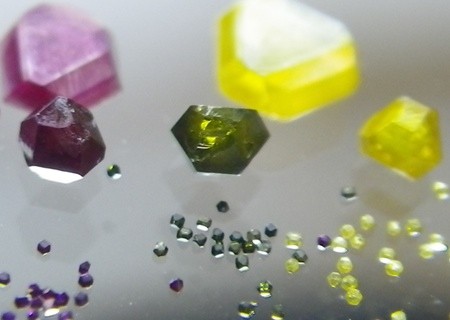Nanodiamonds could enable real-time monitoring of cancer cell processes
Post Date: 26 Oct 2013 Viewed: 880
Nanometric-scale diamond particles could offer a new way to detect cancer far earlier than previously thought, which is the aim of an EU-funded research project called Dinamo. The project aims to develop a noninvasive nanotechnology sensing platform for real-time monitoring of biomolecular processes in living cancer cells, reports Commnet.
Researchers involved in the Dinamo project developed a new technique based on the use of fluorescent nanodiamond particles (NDPs). "We demonstrated that the specific combination of NDP properties make them a highly suitable material for the construction of probes capable of sensing biomolecules ranging from proteins to DNA,” says team coordinator Milos Nesladek, who is also principal scientist at the Institute for Material Research (imec; Leuven, Belgium). “Such probes could be used to study molecular processes in cells at nanoscale," he says.
The trouble is that previous solutions did not allow monitoring processes within living cells for any extended period of time. "Our key challenge was to replace fluorescent biomolecular dyes that are currently used as luminescence markers in cancer cell research,” explains Nesladek.

NDPs present several advantages: they are highly biocompatible, can remain for prolonged periods inside cells without influencing any cellular mechanisms, and can be engineered to obtain a range of optic, magnetic, and surface properties. “The small size of NDPs enables them to penetrate individual cell membranes in a noninvasive way, which causes no damage to the cell and without any disruption of normal cellular functions," says Nesladek. “The luminescence and the magnetic properties change depending on the NDP’s interaction with the cellular environment,” he adds.
Surface properties of NDPs enable attachment of specific biomolecules, such as primary DNA molecules. Delivered precisely to the target cell, these biomolecules can measure, monitor, or alter biological components within the cell. The NDPs can thus become not only a tool to monitor and detect precancerous changes, but also to rectify them. Further developments are going on in subsequent EU projects such as DIAMANT.
Some experts welcome this approach. “Development of new drug delivery carriers is crucial for treatment of numerous deceases, including cancer,” comments Fedor Jelezko, director of the Institute of Quantum Optics at Ulm University in Germany. “The novelty of approach in [the project] is the use of innovative material to transport drugs,” he says. Nanodiamond provides unique opportunities for drug carrier design since they can be imaged optically using fluorescence microscopy. “This allows monitoring of drug delivery and release of drugs in the cells with unprecedented details,” he adds. This monitoring has already been demonstrated by teams of the Ecole Normale Sup�rieure (ENS; Cachan, France) and Gustave Roussy Cancer Institute (Paris, France).
Other experts are more cautious. “Although there have been numerous convincing experiments showing that nanodiamonds can carry active anti-cancer drugs in culture cells and even in mice, it is very unlikely that it will be ever used in humans, mostly because diamond is so inert that it cannot be degraded and therefore cannot be easily eliminated by the body," comments Fran�ois Treussart, physics professor at the ENS.
However, he seems a bright future for the technology. “Far beyond the [project] goals, nanodiamond future in medical applications is more as a diagnostic device in personal medicine or as a monitoring tool for example to track stem cell engraftment in regenerative medicine, as recently demonstrated by the biomedical applications of fluorescent ND-team at the Institute of Atomic and Molecular Science, at the Academia Sinica in Taiwan,” he concludes.
A NDP probe, placed in a target cell, should be able to detect and relay information about the processes taking place in this cell. "The Dinamo project has been finished, but the partners still are collaborating," Nesladek explains, adding that the University of Stuttgart in Germany is developing such a probe.
"Dinamo has focused on the context of breast cancer and colorectal cancer, but there is no reason why the technique could not be applied to a wide range of other cancers,” says Nesladek. He concludes that another future aim is to explore the possibility of using NDP probes to detect cancer stem cells.



